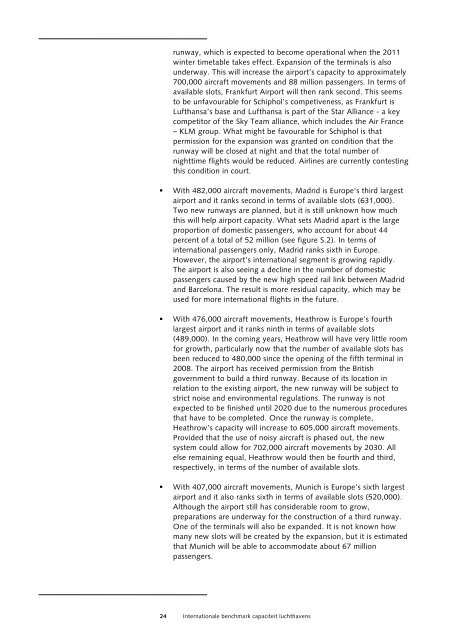Internationale benchmark capaciteit luchthavens - Kennisinstituut ...
Internationale benchmark capaciteit luchthavens - Kennisinstituut ...
Internationale benchmark capaciteit luchthavens - Kennisinstituut ...
Create successful ePaper yourself
Turn your PDF publications into a flip-book with our unique Google optimized e-Paper software.
unway, which is expected to become operational when the 2011<br />
winter timetable takes effect. Expansion of the terminals is also<br />
underway. This will increase the airport’s capacity to approximately<br />
700,000 aircraft movements and 88 million passengers. In terms of<br />
available slots, Frankfurt Airport will then rank second. This seems<br />
to be unfavourable for Schiphol’s competiveness, as Frankfurt is<br />
Lufthansa’s base and Lufthansa is part of the Star Alliance - a key<br />
competitor of the Sky Team alliance, which includes the Air France<br />
– KLM group. What might be favourable for Schiphol is that<br />
permission for the expansion was granted on condition that the<br />
runway will be closed at night and that the total number of<br />
nighttime flights would be reduced. Airlines are currently contesting<br />
this condition in court.<br />
With 482,000 aircraft movements, Madrid is Europe’s third largest<br />
airport and it ranks second in terms of available slots (631,000).<br />
Two new runways are planned, but it is still unknown how much<br />
this will help airport capacity. What sets Madrid apart is the large<br />
proportion of domestic passengers, who account for about 44<br />
percent of a total of 52 million (see figure S.2). In terms of<br />
international passengers only, Madrid ranks sixth in Europe.<br />
However, the airport’s international segment is growing rapidly.<br />
The airport is also seeing a decline in the number of domestic<br />
passengers caused by the new high speed rail link between Madrid<br />
and Barcelona. The result is more residual capacity, which may be<br />
used for more international flights in the future.<br />
With 476,000 aircraft movements, Heathrow is Europe’s fourth<br />
largest airport and it ranks ninth in terms of available slots<br />
(489,000). In the coming years, Heathrow will have very little room<br />
for growth, particularly now that the number of available slots has<br />
been reduced to 480,000 since the opening of the fifth terminal in<br />
2008. The airport has received permission from the British<br />
government to build a third runway. Because of its location in<br />
relation to the existing airport, the new runway will be subject to<br />
strict noise and environmental regulations. The runway is not<br />
expected to be finished until 2020 due to the numerous procedures<br />
that have to be completed. Once the runway is complete,<br />
Heathrow’s capacity will increase to 605,000 aircraft movements.<br />
Provided that the use of noisy aircraft is phased out, the new<br />
system could allow for 702,000 aircraft movements by 2030. All<br />
else remaining equal, Heathrow would then be fourth and third,<br />
respectively, in terms of the number of available slots.<br />
With 407,000 aircraft movements, Munich is Europe’s sixth largest<br />
airport and it also ranks sixth in terms of available slots (520,000).<br />
Although the airport still has considerable room to grow,<br />
preparations are underway for the construction of a third runway.<br />
One of the terminals will also be expanded. It is not known how<br />
many new slots will be created by the expansion, but it is estimated<br />
that Munich will be able to accommodate about 67 million<br />
passengers.<br />
24 <strong>Internationale</strong> <strong>benchmark</strong> <strong>capaciteit</strong> <strong>luchthavens</strong>




